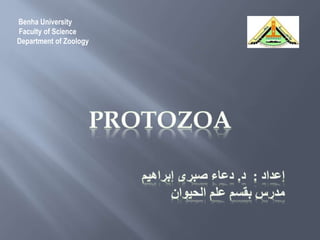Protozoa 2
•Als PPTX, PDF herunterladen•
2 gefällt mir•477 views
http://www.bu.edu.eg/staff/doaamohamed7
Melden
Teilen
Melden
Teilen

Empfohlen
Weitere ähnliche Inhalte
Was ist angesagt?
Was ist angesagt? (20)
Nemathelminthes general characters and classification

Nemathelminthes general characters and classification
General characteristics of Porifera | Dr.BGR Publications

General characteristics of Porifera | Dr.BGR Publications
General Characteristics of Echinodermata | Dr.BGR Publications

General Characteristics of Echinodermata | Dr.BGR Publications
Andere mochten auch
Andere mochten auch (11)
Ähnlich wie Protozoa 2
Ähnlich wie Protozoa 2 (20)
Kürzlich hochgeladen
God is a creative God Gen 1:1. All that He created was “good”, could also be translated “beautiful”. God created man in His own image Gen 1:27. Maths helps us discover the beauty that God has created in His world and, in turn, create beautiful designs to serve and enrich the lives of others.
Explore beautiful and ugly buildings. Mathematics helps us create beautiful d...

Explore beautiful and ugly buildings. Mathematics helps us create beautiful d...christianmathematics
Kürzlich hochgeladen (20)
Python Notes for mca i year students osmania university.docx

Python Notes for mca i year students osmania university.docx
Unit-V; Pricing (Pharma Marketing Management).pptx

Unit-V; Pricing (Pharma Marketing Management).pptx
Seal of Good Local Governance (SGLG) 2024Final.pptx

Seal of Good Local Governance (SGLG) 2024Final.pptx
ICT Role in 21st Century Education & its Challenges.pptx

ICT Role in 21st Century Education & its Challenges.pptx
Kodo Millet PPT made by Ghanshyam bairwa college of Agriculture kumher bhara...

Kodo Millet PPT made by Ghanshyam bairwa college of Agriculture kumher bhara...
General Principles of Intellectual Property: Concepts of Intellectual Proper...

General Principles of Intellectual Property: Concepts of Intellectual Proper...
Basic Civil Engineering first year Notes- Chapter 4 Building.pptx

Basic Civil Engineering first year Notes- Chapter 4 Building.pptx
Explore beautiful and ugly buildings. Mathematics helps us create beautiful d...

Explore beautiful and ugly buildings. Mathematics helps us create beautiful d...
On National Teacher Day, meet the 2024-25 Kenan Fellows

On National Teacher Day, meet the 2024-25 Kenan Fellows
Protozoa 2
- 1. Benha University Faculty of Science Department of Zoology
- 2. Absence of chromatophores (chloroplasts). There are one to many flagella, often undulating membrane is present. Holozoic or saprozoic nutrition. Parasitic, commensal or symbiotic. Reproduction through binary fission.
- 3. Animal Kingdom Subkingdom: Protozoa Phylum: Protozoa Subphylum: Mastigophora Class: Zoomastigophorea e.g.: Trypanosoma
- 4. Trypanosomes are parasitic flagellates. They usually live in two hosts, an invertebrate, either insect or leech (intermediate host) and a vertebrate host (definitive or final host).
- 5. Morphology:
- 6. Locomotion: By the vibrating movements of the undulating membrane and the flagellum, thus the body moves in a similar manner. Nutrition: They are capable to engulf small droplets of blood plasma by a process known as pinocytosis.
- 8. Body is amoeboid. Locomotion and feeding by pseudopodia. Single nucleus. Nutrition is holozoic, saprozoic. Reproduction mostly by binary fission. Most species are solitary and free-living, some species are parasitic
- 14. a. Binnary fission b. Encystment
- 15. Simple and compound cilia, the organs of locomotion are present. They have two types of nuclei, a small 'micronucleus' and a large 'macronucleus'. Nutrition is holozoic. Most of them are free-living, and few are parasitic. Reproduction may be asexual or sexual.
- 21. a. Transverse Binnary Fission
- 22. b. Conjugation
- 23. Conjugation: This process includes the following steps: Two individuals become sticky, adhere to one another by their oral surfaces and a protoplasmic bridge is formed between them. Each of these individuals is referred to as a conjugant. The macronucleus in each conjugant breaks into pieces and ultimately degenerates. In the meantime the micronucleus divides twice by mitosis to form four nuclei, each with the normal diploid number of chromosomes. Of these four nuclei three degenerate and only one is left. The remaining nucleus divides by a reduction division (meiosis) into two nuclei; a small migratory (male) nucleus and a larger stationary (female) nucleus. Each of these two nuclei is haploid, containing half the number of chromosomes found in the original nucleus. The migratory nucleus in each conjugant becomes active, move into other conjugant and fuses with the stationary nucleus therein. Thus in each conjugant a zygotic or fusion nucleus is formed which contains the original diploid number of chromosomes. When this fusion is completed, the two pairing paramecia separate and they are now refered to as the exconjugants. The zygotic nucleus in each ex-conjugant divides thrice forming eight nuclei each with the diploid number of chromosomes. Four of these nuclei enlarge and become polyploid, thus forming macronuclei; while the other four remain as diploid micronuclei. This is followed by two cytoplasmic divisions and accordingly four new daughter paramecia are produced from every ex-conjugant, each with one macronucleus and one micronucleus.